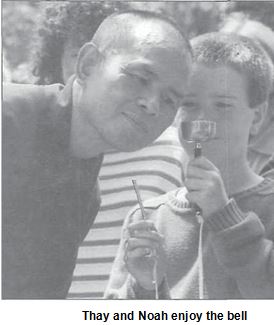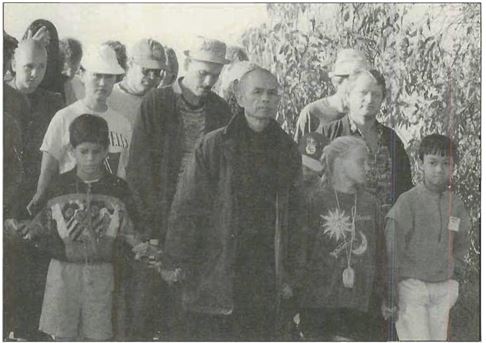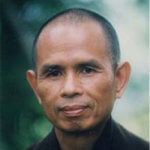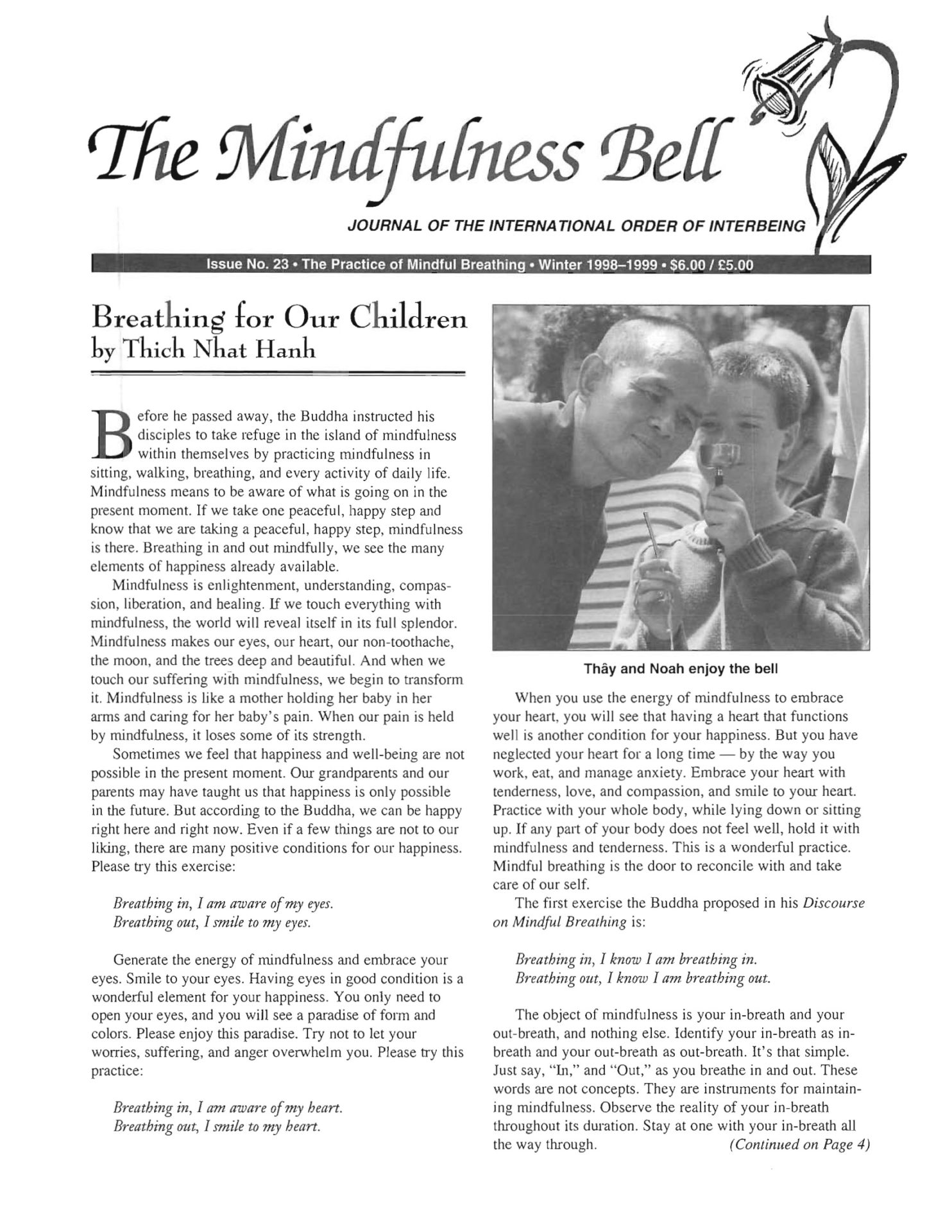Before he passed away, the Buddha instructed his disciples to take refuge in the island of mindfulness within themselves by practicing mindfulness in sitting, walking, breathing, and every activity of daily life. Mindfulness means to be aware of what is going on in the present moment. If we take one peaceful, happy step and know that we are taking a peaceful, happy step, mindfulness is there. Breathing in and out mindfully, we see the many elements of happiness already available.
Before he passed away, the Buddha instructed his disciples to take refuge in the island of mindfulness within themselves by practicing mindfulness in sitting, walking, breathing, and every activity of daily life. Mindfulness means to be aware of what is going on in the present moment. If we take one peaceful, happy step and know that we are taking a peaceful, happy step, mindfulness is there. Breathing in and out mindfully, we see the many elements of happiness already available.

Mindfulness is enlightenment, understanding, compassion, liberation, and healing. If we touch everything with mindfulness, the world will reveal itself in its full splendor. Mindfulness makes our eyes, our heart, our non-toothache, the moon, and the trees deep and beautiful. And when we touch our suffering with mindfulness, we begin to transform it. Mindfulness is like a mother holding her baby in her arms and caring for her baby's pain. When our pain is held by mindfulness, it loses some of its strength.
Sometimes we feel that happiness and well-being are not possible in the present moment. Our grandparents and our parents may have taught us that happiness is only possible in the future. But according to the Buddha, we can be happy right here and right now. Even if a few things are not to our liking, there are many positive conditions for our happiness. Please try this exercise:
Breathing in, I am aware of my eyes. Breathing out, I smile to my eyes.
Generate the energy of mindfulness and embrace your eyes. Smile to your eyes. Having eyes in good condition is a wonderful element for your happiness. You only need to open your eyes, and you will see a paradise of form and colors. Please enjoy this paradise. Try not to let your worries, suffering, and anger overwhelm you. Please try this practice:
Breathing in, I am aware of my heart. Breathing out, I smile to my heart.
When you use the energy of mindfulness to embrace your heart, you will see that having a heart that functions well is another condition for your happiness. But you have neglected your heart for a long time — by the way you work, eat, and manage anxiety. Embrace your heart with tenderness, love, and compassion, and smile to your heart. Practice with your whole body, while lying down or sitting up. If any part of your body does not feel well, hold it with mindfulness and tenderness. This is a wonderful practice. Mindful breathing is the door to reconcile with and take care of our self.
The first exercise the Buddha proposed in his Discourse on Mindful Breathing is:
Breathing in, I know I am breathing in. Breathing out, I know I am breathing out.
The object of mindfulness is your in-breath and your out-breath, and nothing else. Identify your in-breath as in-breath and your out-breath as out-breath. It's that simple. Just say, "In," and "Out," as you breathe in and out. These words are not concepts. They are instruments for maintaining mindfulness. Observe the reality of your in-breath throughout its duration. Stay at one with your in-breath all the way through.

You don't need to make an effort to stop your thinking. Just by concentrating on your in-breath one hundred percent, your thinking will quiet itself. You don't need to "force" yourself to be mindful. Just enjoy your breathing. When the practice is pleasant, concentration becomes easy, and insight is born. Mindfulness, concentration, and insight always go together.
Sit or lie down in a way that allows your body to rest. Sitting, your head and spine form a straight line. Relax all your muscles. If you are sitting on a cushion, select one that is the correct thickness for your physical condition. Find a way of sitting that allows you to sit for at least twenty minutes, without becoming too stiff or tired. As soon as you sit down, pay attention to your breath. Then notice your posture, a little bit everywhere. Relax the muscles in your face. If you are angry or worried, those muscles will be tense. Smile lightly, and you will relax hundreds of muscles in your face. Then notice your shoulders, and let go of the tension there. Don't try too hard. Just breathe mindfully, and scan your whole body.
When you watch TV, you can sit for a long time. But in meditation, you struggle. Why not imitate the way you sit watching television? The key is effortlessness. Don't fight or try too hard. Just allow yourself to sit in a relaxed way, and you will feel deeply calm. A period of sitting meditation is time worth living. Don't interfere with your breathing. Breathing takes place by itself. Just light the lamp of mindfulness and shine it on your breathing. Don't modify, bend, or make your breathing the way you think it is supposed to be. This is mindfulness of breathing, not intervention. Just become aware of your in-breath and out-breath as they are. If your in-breath is short, let it be short. If your out-breath is long, let it be long. Become aware of your in-breath and out-breath as they are. Don't try to make them shorter or longer. After a few minutes of practice, you will notice an improvement in the quality of your breathing, and a feeling of well-being will be born in you.
Mindfulness recognizes what is there, and concentration allows you to be deeply present with whatever it is. Concentration is the ground of happiness. If you live twenty-four hours a day in mindfulness and concentration, one day is a lot. Each moment of your life can become a legend. The Buddha didn't leave behind a theory or set of dogmas. He left behind his life. Every step he took was solid and peaceful. His compassion penetrated the living beings of his time, and the living beings of today, as well. Each step, each breath, and each of his words convey the energy of mindfulness, understanding, and compassion. The practice is to live mindfully and deeply each moment of your daily life, to return to your true home in the present moment.
But many of us do not want to go home to ourselves. We were wounded as children, and it is hard for us to trust others or allow their love to penetrate us. So, instead of going home, we make every effort to avoid ourselves. We say we don't have enough time to be with ourselves, and even when we do have five or ten minutes, we turn on the TV, pick up a magazine, or get in the car and go out for a drive. We haven't been in close touch with our body, our feelings, and our mind for a long time. We are afraid to go home to ourselves, because we don't have the means to protect ourselves from the suffering that is within us. But mindfulness can be our protection, making it possible for us to go home safely. With mindfulness, we can touch the wounded child within and embrace him or her without being overwhelmed. With training in mindful breathing and walking, we will be able to go home and embrace our suffering. The practice is to prepare ourselves to go back and touch the wounded child within. Doing this will help many beings — past, present, and future -- and not only ourselves.
To practice is not to transform ourselves into a battlefield, the good fighting the evil. There is no battle. There are only positive and negative elements within us, and both sides are us. We can embrace all of them, and when we do, the negative elements will transform themselves into positive ones, without any fighting or discarding. We need to learn to transform our garbage into compost. If we continue to practice dwelling in mindfulness, accepting all the elements we discover within us as ourselves, one day our wounds won't force us to do and say things we don't want to do or say, anymore. With mindful breathing, we learn to recognize our unwholesome mental formations even before they arise, and we can stop being the victim of the habit energies we've received from so many generations of ancestors. At that moment, we become an instrument in the work of transformation, for our own sake and for the sake of our ancestors and future generations.
The Buddha gave many talks on breathing in and breathing out in mindfulness. My little book, Breathe! You Are Alive, presents several of these, with commentaries on how to practice. The Buddha did not offer these exercises as theories or means for analysis. He offered them as concrete practices for us to do. Please practice mindful breathing, and enjoy your breathing. Breathing is enjoyable.
Twenty years ago we could not have imagined non-smoking flights. We suffered for years every time we had to sit in an airplane among those who were smoking. Now, thanks to our collective awakening, there are many non-smoking flights all over the world. Awakening is possible. In every one of us there is a seed of awakening. We should have confidence in this seed, and not be overwhelmed by despair. The practice is to touch the positive elements that are already there, so we will benefit from these elements and realize awakening.
If you practice mindful breathing, mindful smiling, mindful walking, and mindful working, your stability and strength will inspire those around you. Please practice together as a Sangha. When you see a group of people living mindfully, capable of smiling and loving, it will give you confidence in the future. Please learn the art of Sangha building. We mustn't allow the younger generation to lose hope. Breathe, walk, act, and live each moment of life in a way that demonstrates to our children that a future is possible.
This Dharma talk is from Thich Nhat Hanh's 21-Day Retreat in Burlington, Vermont, in June 1998, on The Path of Emancipation. The talks will be published by Parallax Press in 1999.
Photo: Mark Sternfield.
To request permission to reprint this article, either online or in print, contact the Mindfulness Bell at editor@mindfulnessbell.org.


